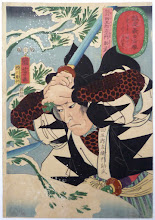Medieval Japanese currency has been on my mind lately. For Flying Swordsmen, with its emphasis on crazy kung fu action over adventuring for treasure, the simple system of Dragon Fist, tael (gold) and fen (copper) was good enough. So far, in Chanbara I've just switched the names to ryo and zeni.
But looking at one of my history books on Tokugawa Japan, there's a convoluted system that's full of flavor but would likely be a bookkeeping nightmare in play.
Early on, the Japanese just imported coinage from China (and possibly Korea). Later, the shogunate began to mint coins. But local daimyo were also able to mint their own coins for their provinces. And there ended up being three separate currencies.
Gold coins were the ryo (mentioned above), the bu (1/4 a ryo), and the shu (1/4 a bu or 1/16 a ryo). One ryo was enough to buy one koku of rice, about 5 bushels/180 liters, considered enough rice to feed one person for a year. Samurai salaries were calculated in koku of rice.
Silver coins were the monme and the kan (1000 monme). The official exchange rate with the ryo was 50 monme to the ryo, later raised to 60 monme to the ryo.
Bronze/Copper coins (zeni) were the mon and kan (1000 mon). The official exchange rate with the ryo was 4000 mon.
--the above taken from Nakane, Chie and Oishi, Shinzaburo, Tokugawa Japan: The Social and Economic Antecedents of Modern Japan (1990), English translation edited by Conrad Totman.
Now, part of me thinks it would be fun to have all of these different coins floating around in Chanbara, but just getting the names straight might be tough enough for many players, let alone trying to remember all of the conversions.
So I think I'm going to just use some of the names as analogous to D&D coinage.
*Platinum piece = oban (a large gold disk used for savings rather than as currency), only the oban will be worth about 20 ryo as with a silver kan, rather than the standard 5gp to 1pp.
Gold piece = ryo
Electrum piece = bu? Not sure if I'll include this one
Silver piece = monme
Copper piece = zeni
That should make things easier.
Now to figure out how I want to do treasure tables, and revise prices on the equipment lists...
The "Competition"
4 hours ago






I think your players might surprise you. If you look at the Pendragon mechanics, they have a system to account for three volumes of currency, the shilling, the denarii, and the libra.
ReplyDeleteThe exchange rate between the three is somewhat ridiculous, and even I don't really follow it after about 2 years of playing the game itself, essentially it kind of translates to:
1 libra = 20 shillings = 240 denarii (something I always have to google)
Despite potentially being frustrating to players, especially due to the digging necessary to find out the exact exchange rate, players never really have to deal with it unless they so desire, because the majority of the game focuses on Libra.
Now, your game may focus a bit more on the smaller currencies, but as long as you keep the exchange rates somewhere visible and easily accessible, it shouldn't be a problem for players.
And, on a more personal note, I tend to enjoy learning about how other cultures handled their currency, possibly because it makes me feel a bit better about the complete mess that is the imperial measurement system.
Maybe. The other downside would be that the treasure tables would be more complex. Meaning more work for my lazy self. :D
ReplyDeleteLike you say, though, characters will mostly be dealing with ryo, so mabye it's not such a bad thing to have the other coins floating about.
It all really depends on the amount of realism you want to include. You can have the baseline for prices be ryo, and offer the GM the choice between the historically accurate denominations or your D&D analogy exchange rate.
Delete